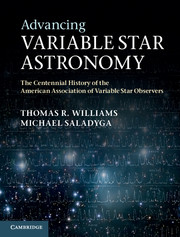 Advancing Variable Star Astronomy
Advancing Variable Star Astronomy Book contents
- Frontmatter
- Contents
- Foreword
- Preface
- Acknowledgments
- PART I PIONEERS IN VARIABLE STAR ASTRONOMY PRIOR TO 1909
- PART II THE FOUNDING OF THE AAVSO – THE WILLIAM TYLER OLCOTT ERA
- PART III RECORDING AND CLASSIFICATION – THE LEON CAMPBELL ERA
- PART IV THE SERVICE BUREAU – THE MARGARET MAYALL ERA
- 10 Learning about independence
- 11 Eviction from Harvard College Observatory
- 12 Actions and reactions
- 13 In search of a home
- 14 Survival on Brattle Street
- 15 AAVSO achievements
- 16 Breathing room on Concord Avenue
- PART V ANALYSIS AND SCIENCE – THE JANET MATTEI ERA
- PART VI ACCELERATING OBSERVATIONAL SCIENCE – THE ARNE HENDEN ERA
- Appendix A AAVSO historiographic notes
- Appendix B Top AAVSO observer totals
- Appendix C Variable star observing groups represented in the AAVSO International Database
- Appendix D AAVSO Awards
- Appendix E Officers of the AAVSO
- Appendix F AAVSO Council members
- Appendix G AAVSO Scientific committee, section, division, and program chairs
- Notes
- Bibliography
- Index
10 - Learning about independence
from PART IV - THE SERVICE BUREAU – THE MARGARET MAYALL ERA
Published online by Cambridge University Press: 13 June 2011
- Frontmatter
- Contents
- Foreword
- Preface
- Acknowledgments
- PART I PIONEERS IN VARIABLE STAR ASTRONOMY PRIOR TO 1909
- PART II THE FOUNDING OF THE AAVSO – THE WILLIAM TYLER OLCOTT ERA
- PART III RECORDING AND CLASSIFICATION – THE LEON CAMPBELL ERA
- PART IV THE SERVICE BUREAU – THE MARGARET MAYALL ERA
- 10 Learning about independence
- 11 Eviction from Harvard College Observatory
- 12 Actions and reactions
- 13 In search of a home
- 14 Survival on Brattle Street
- 15 AAVSO achievements
- 16 Breathing room on Concord Avenue
- PART V ANALYSIS AND SCIENCE – THE JANET MATTEI ERA
- PART VI ACCELERATING OBSERVATIONAL SCIENCE – THE ARNE HENDEN ERA
- Appendix A AAVSO historiographic notes
- Appendix B Top AAVSO observer totals
- Appendix C Variable star observing groups represented in the AAVSO International Database
- Appendix D AAVSO Awards
- Appendix E Officers of the AAVSO
- Appendix F AAVSO Council members
- Appendix G AAVSO Scientific committee, section, division, and program chairs
- Notes
- Bibliography
- Index
Summary
It is human nature always to strive to reach fainter and more distant objects. …
– Margaret W. Mayall, 1950, from a radio talk about Annie Jump CannonWith the retirement of Leon Campbell in 1949, the AAVSO waited expectantly for an announcement of who would replace him as the second AAVSO Recorder. The choice was important: knowledgeable members recognized the change would come at an obvious inflection point in the history of variable star astronomy.
Although well established and recognized in both the scientific community and by amateur observers, the AAVSO was in a state of change. The Old Guard, so instrumental in its survival, had faded away, and the organization was looking for new leaders. Its affiliation with HCO had been facilitated by Campbell, who served as AAVSO Recorder and Pickering Memorial Astronomer. Whether he would be replaced by Harvard College was a question of vital importance to the organization. At the same time, HCO and its Director Harlow Shapley were fighting their own struggle to replace deteriorating equipment and to support their far-flung operations in Africa. This chapter provides background on Campbell's successor, Margaret W. Mayall, explores her early career at HCO and her first years as AAVSO Recorder, and shows how she responded to the emerging crisis that threatened the continued existence of the AAVSO.
- Type
- Chapter
- Information
- Advancing Variable Star AstronomyThe Centennial History of the American Association of Variable Star Observers, pp. 129 - 152Publisher: Cambridge University PressPrint publication year: 2011


